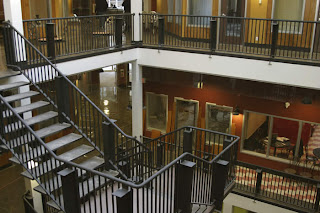Inside his singular dwelling space and studio, the workings of Tim Rechner's mind are splayed out for all to view. Mad scribbles line the studio walls from floor to ceiling -budding ideas spilling over immediate thoughts and untethered ramblings both energized and voracious, scraps of paper ranging from post-it notes to oversized hand-stretched canvases topple over one another. Layer after layer, level after level, condensed expressions and illuminated sketches piece together every inch of available wall space.

Image credit: Rechner and Tony the cat by Ted Kerr, 2007.
On the surface, Rechner's studio apartment in Edmonton's ArtsHab epitomizes a romantic notion of an "artist" space. Most people may have first seen his apartment in Trevor Anderson's short film, Rugburn (2005), where Rechner's actual day-to-day living space served as a set for Anderson's tempestuous artist.
Large in presence with a full head of massive dark curls and an even fuller dark beard, Rechner speaks in a very hushed and subdued tone accompanied with periodic small hand gestures. "I think the role of an artist here is to make Edmonton more culturally interesting," he begins once we settle inside the studio with his cats, Jimmy and Harold, nearby. "I don't want to sound spoiled or righteous, but I personally feel a drive to really create things as much as I can."
As the longest tenant in ArtsHab, the only city-sanctioned artist's co-op in Edmonton, Rechner has rooted himself into a steady arts community. With regular exhibition openings coupled with open studio visits every six weeks, he has a continuous feed of stimuli that conveniently lingers outside his front door.
A graduate of the Nova Scotia College of Art + Design and Red Deer College, Rechner has built up his exhibitions from small cafe shows to public murals, culminating in his year-long residency at Edmonton's Harcourt House Gallery in 2006. Expressionistic and intuitive, Rechner's work often draws parallels to abstract expressionism, but Rechner himself doesn't feel aligned to any formal school of aesthetics. Working from his subconscious, there is a pure approach in his already-trademark expressions between line and colour.
"I'm moving in a more honest and free way than I have before," Rechner says as he sits up and moves one arm across in a single sweeping motion. "I'm now moving my arms, and not just my wrists, and my strokes are reaching my full length span."
At 6'1, the energy and physicality involved in each of his pieces have taken Rechner to a new level. After returning from a self-directed residency in Catalonia, Spain, this past summer, Rechner's daily ritual of art-making has spawned a tighter structure to his subconscious spurts. Taking note of contemporary Spanish artist Anthony Tapies, Rechner's signature style of abstraction is starting to crystallize into work that is structurally sound.

Image Credit: Tim Rechner, Emily's Dream, 2006, oil and graphite on canvas
"I feel like I'm on the verge of something groundbreaking," he says of the drawings made during his residency in Spain, as well as the works completed upon return. Cash-strapped from his trip, Rechner has begun painting over older work in lieu of fresh canvas. Pausing to reflect this watershed moment, Rechner has no regrets. "I'm going over a lot of my older pieces and wondering if I really want to keep these, because I know I can do something better."
One of the results from painting over an existing work is "Morning Light," a piece he believes to be the best work he has yet to do. Picked up by Front Gallery this past year and completing his first commercial solo exhibition in the spring, the commercial world remains foreign to Rechner, who is more accustomed to a DIY effort.
Front Gallery Director Gregoire Barber describes Rechner as somebody she has "known of" for several years. She has come to know him personally in the last year and a half and believes he just needs time. "Tim's paintings and drawings are now starting to come together. The visual amount he was taking in overseas, it's just going to happen."
As the proprietor and director of a gallery representing only local artists, Barber notes that it has been an uphill battle since taking over Front Gallery three years ago. "I believe in the work, but it takes time for people to know that this work is here; that there this is a new body of work with a different style."
In the meantime, Rechner shares that he has begun applying for shows across the board from Victoria to Halifax. "I'm trying to connect as far as I can," he says. "I've shown a lot here and it's time to get to that next stage."
First Published in Galleries West, Volume 6, Number 3, Fall 2007. Print and Online.
















+Kindregan.jpg)
+Louter.jpg)











